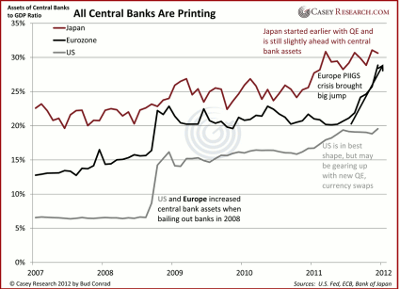It’s important to explore the deeper implications of the recent announcement from the Federal Reserve, so you can maximize your investments as the consequences unfold, writes Bud Conrad of The Casey Report.
The Federal Reserve recently announced important policy changes at its Federal Open Market Committee (FOMC) meeting. Here are the three most important takeaways, in its own words:
The Committee decided to keep the target range for the federal funds rate at 0 to 0.25%, and currently anticipates that economic conditions—including low rates of resource utilization and a subdued outlook for inflation over the medium run—are likely to warrant exceptionally low levels for the Federal funds rate at least through late 2014.
The Committee judges that inflation at the rate of 2%, as measured by the annual change in the price index for personal consumption expenditures, is most consistent over the longer run with the Federal Reserve’s statutory mandate.
Finally, in the most recent projections, FOMC participants’ estimates of the longer-run normal rate of unemployment had a central tendency of 5.2% to 6%.
Immediate Reactions
The first item is the most important as it was not expected—and it had an immediate effect on markets. Gold spiked higher on the surprise news of extending the zero-rate policy through 2014. The news prompted a similar jump in silver services.
Keeping rates low requires the Fed to print new money to buy Treasuries, so the dollar weakened against the euro, although the reaction wasn’t as big as in the gold and silver markets. This is partially due to the fact that the ECB is on its own campaign of printing money.
The most important action of the three was to extend the zero Fed funds rate to the end of 2014. This is a form of easing that could affect more rates than just short-term rates. Furthermore, there is a debate as to whether the action was the result of the Fed’s concern about the economy slipping back into recession.
Or, this could also be a bullish sign for the economy and stock market, as the guaranteed low rates could increase investment to improve our economy. Zero rates drive investors to take on risks—such as buying stocks—to gain higher returns. As a result, this induces more investment toward riskier parts of the market, which might otherwise be underfunded.
Though the Fed aims to stimulate the economy, we’re more likely to see a slip back into recession rather than see an effective Fed stimulus improving the economy.
The press conference suggested that quantitative easing (QE) remains on the table. As a result, new targeted asset purchases by the Fed are likely in our future. These additional purchases with newly printed money could become inflationary. That is why gold shot higher and the dollar weakened in the short term.
Both the Fed and the ECB have decidedly less-hawkish members and leadership than just last year. Both have now moved toward more moneyprinting to keep rates low. This chart of central bank balance sheet as a ratio to GDP shows that the central banks of the world are clearly "printing":
Longer-Term Implications
The problem with printing money and promising to do so for years ahead of time is that the negative consequences of inflation only happen after a delay. As a result, it’s difficult to know if a policy has gone too far until years down the road at times.
Unfortunately, if confidence in the dollar is lost, the consequences cannot be easily reversed. Another problem for the Fed itself is that it holds long-term securities that will lose value if rates rise.
The federal government faces an even more serious problem when interest rates rise, as higher rates on its debt mean greater interest payments to service. Due to this federal-government debt burden, the Fed has an incentive to keep rates low, even if the long-term result is higher inflation. However, for now the Fed’s statement suggests it sees inflation as "subdued," so it’s putting those concerns aside for now.
Along with the promise of low rates, the Fed for the first time gave an inflation target of 2%, as measured by Personal Consumption Expenditures. The actual and target inflation show that the Fed is currently not under major pressure from missing its target…not yet.
The Fed has not even tried to set a target for the unemployment rate, which is only expected to edge below 8% by 2013. The Fed says that that the longer-run unemployment range is 5% to 6%. The big difference from the current level of 8.5% indicates that the Fed faces a greater challenge with unemployment than inflation now.
My conclusion from the Fed’s actions is that it doesn’t care as much about its inflation target as it does about improving the unemployment rate. Thus, it will err on the side of letting inflation rise, if it would improve unemployment.
But holding rates too low too long fueled the housing bubble. Repeating the same game will have consequences of malinvestment in the form of new bubbles in the economy. The Fed hopes to restore employment before the negative consequences of loose monetary policy show up.
Over the long run, the Fed expects the funds rate to rise to around 4.25%. Eleven of the members indicate that the rate will rise before 2015. Only six expect the rate to stay close to zero through 2014.
The gold price is driven by Fed policies and its bias toward printing money rather than defending the dollar’s purchasing power. This Fed bias was again reconfirmed by this announcement.
With all the Fed’s renewed vigor toward keeping rates low longer, we can once again reconfirm the ongoing downward slide for the dollar. As a result, gold remains the best investment against the damaging government deficits and central-bank policies around the world.
Subscribe to The Casey Report here…
Related Reading:






















